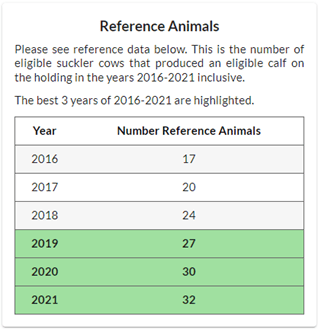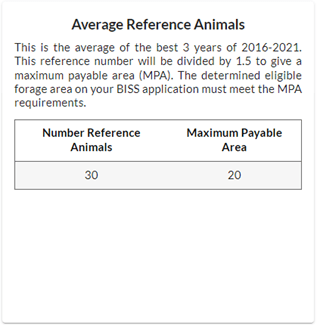ICBF in collaboration with DAFM and Bord Bia have conducted a number of information sessions around the country to present and explain the new Suckler Carbon Efficiency Programme (SCEP). We have collated a list of the most frequently asked questions from the events. These can be seen below.
If you have a question that is not listed below, please contact the HerdPlus office on 023-8820452 or email [email protected].
SCEP FAQ’s
Q. Where can I find my reference number for SCEP?
This can be obtained from www.agfood.ie. Login to your Agfood.ie account and you will see “AgSchemes – Suckler Carbon Efficiency Programme” as the fourth option on the list. Click this option and then click the “+” symbol on the right hand side (Figure 1) to start an application (clicking this will not submit an application). This will take you to a screen that shows the number of cows calved in each year from 2016-2021 and will highlight the highest 3. On the right hand side it will show your reference number and the number of hectares you will need for this (Figure 2). If you do not have an Agfood.ie account, contact your FAS advisor.

Figure 2. Listing of reference years on the left with the highest 3 years highlighted. The reference number and “Maximum Payable Area” (MPA) are on the right. The MPA is the number of hectares that you will be paid on with this reference number (reference number divided by 1.5)
Q. How does the reference number work for SCEP?
There are essentially 3 elements to the reference number for SCEP
1. Your maximum possible number.
This will be presented to you when you login to Agfood.ie as shown in figure 2. It will be calculated by looking at the number of cows calved in each year from 2016-2021 and taking an average of the best three years.
2. The number that you set as your programme reference number.
You can choose the maximum number as presented to you when you login, or you can set it to any number less than this which is termed the ‘Programme Reference Number’. In the example in figure 2, the herd has a maximum possible reference number of 30. The herdowner can set their programme reference number as 30 or any number less than 30. They cannot, however, go above 30. Whatever number you choose, this will be your maximum reference number for the duration of the programme. If you choose to reduce, you will not be allowed to increase back up to the original reference number presented to you on your application on day 1.
3. Your yearly reference number.
You can then set a yearly reference number. In the example given, if the herdowner sets the programme reference number at 30, they can reduce their annual number for year 1 by up to 20%. Therefore, the herdowner could set their year 1 reference number to anything from 30-24. In year 2, they can reduce by another 20% on the previous year’s number and so on. Table 1 outlines the changes that the herd can make to its yearly reference number.

In year 4, the herd went from 20 back up to their full programme reference number of 30. The maximum 20% reduction applies to the previous year’s reference number. An applicant can increase their yearly reference number in any year, up to a maximum of the programme reference number set at application stage.
Q. I have a reference number of 30 but I only have 22 calves born this year. Do I have to weigh at least 80% of my reference number in cow/calf pairs each year?
No. Where there are less calves born than your reference number, you only have to weigh 80% of that number. So, in this example, the herd would need to submit weights on 80% of 22 calves born = 17.6 rounded down to 17. Calves must be weighed between 50 days of age and weaning. Each cow and calf must be weighed on the same day. Where a calf dies under 5 months of age, they will not be included in this calculation. Weights must be submitted to ICBF no later than 1st November each year.
Q. Will females eligible in BDGP be eligible for SCEP?
Yes, if they are still in your herd they will be eligible.
Q. Will stock bulls eligible in BDGP be eligible for SCEP?
Yes, if they are still in your herd they will be eligible.
Q. If my bull is initially genotyped 4/5-star but later drops to 3-star, does it remain eligible?
Yes, the progeny out of this sire will meet the 80% 4/5-star sire requirement.
Q. If a bull is eligible does that make his daughters automatically eligible as 4/5-star females.
No, the daughters of a bull must be genotyped and 4/5-star in their own right to be deemed eligible.
Q. If a bull or female is eligible in my herd, will they automatically be eligible in another herd if I sell them?
No, the animal would need to be 4/5-star at the time of moving into the new herd.
Q. If I buy an animal that was eligible for SCEP in the seller’s herd, will it automatically be eligible in my herd?
No. A purchased animal will only be immediately eligible for SCEP in your herd if it is genotyped and 4/5-stars at the point of purchase. If the animal does not have a genomic evaluation at purchase, it can only become eligible in your herd once it receives a genomic evaluation and is 4/5-stars on same. Do not buy animals based on the evaluation information in another herd’s SCEP eligibility report. These evaluations will be historic in many cases as this is what deems the animal eligible in its current herd. You can check the animal’s current Euro-Star details on the ICBF Animal Search at www.dev-icbf.com. It is also available as an app for Apple and Android devices.
Q. If a bull or female genotypes as a 3-star and is ineligible but later rises to a 4-star, will they become eligible?
Yes, these animals will become eligible. It is important that if you are short of eligible females coming close to one of the 31st Oct deadlines, that you are not depending on these females to increase to 4-star. You could be lucky and they increase in time, but if they don’t, then you’ll miss the target deadline and receive a penalty.
Q. When will genomic tags be going out this year?
The sooner a herd signs up to SCEP the sooner ICBF can start the process of ordering tags. It is unlikely that tags will arrive on farms before May/June. This is only in year 1 as the programme is only open for signups now. There is no reason that tags cannot be issued in Feb/Mar in future years.
Q. If I am participating in DNA calf reg, will these samples be counted towards my BDGP requirement.
Yes
Q. If I’m genotyping animals privately myself, will these samples count towards my BDGP samples?
No. If you are a pedigree breeder sampling animals you should wait for ICBF to issue samples and then sample the remaining calves yourself. If you are Autumn calving, wait until the following spring for samples to be sent out and then you can sample the remaining calves yourself.
Q. Why can’t we get double tissue tags and sample animals at birth?
This could only work in a scenario where the herd is in a DNA calf registration programme. The minister recently announced plans to launch a national genotyping programme which aims to genotype 800,000 cows. This would pave the way for herds to take DNA samples at birth which could then be counted as SCEP genotypes and would remove the need to sample older animals. This won’t be possible for this year (2023) though.
Q. What is the cost of genomic sampling?
It costs €20/animal. A herd with a ref number of 30 will be sampling 21 animals (70%). This would be €420/year. The herd’s gross payment will be €4,275. The annual cost of genotyping, therefore, will be about 9-10% of a herd’s gross payment. This is down from approx. 14% under BDGP.
Q. What is the current 4-star “cut-off” on the Replacement Index.
€99 is the current figure for an animal to hit 4-stars on the Rep Index across breed. The within breed figures can differ a lot, but these are only applicable to pedigree/purebred animals. Check out Beef EuroStar – ICBF after each evaluations to stay on top the cut offs.
Q. The 4-star cut-off was €74 at the start of BDGP. Why has it changed?
As the genetic merit of the national herd increases, so too do the star-rating percentiles. While €25 might seem like a big increase, this is over the course of 8 years (BDGP started in 2015). This equates to only €3/year of €0.5/evaluation (6 evals/year). If we were to “freeze” if for the duration of the programme, the percentiles would not give a true reflection of the national herd throughout the programme. When the “freeze” would be removed at the end of the programme, there would be a sudden big jump in the percentiles which would not be ideal.
Q. Some of my cows were genotyped 4/5-stars during the BDGP but have since dropped to 1, 2 or 3-stars. Will these cows be eligible for SCEP?
Yes, animals that were eligible for BDGP in your herd will remain eligible in your herd for SCEP. This applies to both females and stock bulls. So, for example, if you had a cow or stock bull that was 5-stars on its first genomic evaluation in your herd, but is now 3-stars, it will remain eligible in your herd based on that original genomic evaluation. It will not, however, be eligible in another herd if sold as 1, 2 or 3-stars.
Please contact us on 023-8820452 if you have any questions in relation to the SCEP scheme.


